Being a feminist who is all for women liberation, Noorjehan is one woman in the history of India who intrigues and impresses me beyond any measure. My amnesic memory fails me when I try to recollect when this wonderful woman became an integral part of my reveries. Yes, whenever my routinised existence permits, I never fail to daydream. No, I do not dream to picture myself as Noor, but, I do admit, for reasons I am to explain here, that I secretly often wish to have been born during 1605-1627 AD. I would love to see her in flesh and blood to understand the enigma that she is.
Though I doubt if words would serve as an appropriate and adequate medium to explain this multifaceted personality, my agitated mind compels me to make a beginning. So, here is Noor for you…the woman, as I understand her.
Birth and family history:
Noor was not an Indian by birth. She was born in Kandahar (now in Afghanistan). She was not also an Afghani however. To understand a complex and diverse personality as Noor, one has to shed the jingoistic and parochial approach and look beyond the contemporary geographical boundaries till the present Turkey. See map below.
This old map shows Persia, Kabul and Baluchistan. Upon comparison with the map below, one may see that the present countries of Turkey, Iran Iraq and many more were a part of Persia to which Noorjehan belonged.
Noorjehan’s grandfather was a respected noble in Tehran, then a part of Persia. (Presently, Tehran is the capital of Iran). He died in a battle and his family, fearing bad times, decided to migrate to Hindustan, as India was then known. This family consisted of Mirza Ghiyas Baig, his wife and son named Asaf Baig. En route to Hindustan, Mirza s wife gave birth to a daughter and named her Mihir-un-nisa (sun amongst women). This was in the year 1577 AD in Kandahar (presently in Afghanistan). It is believed that Mihir-un-nisa’s mother had once decided to abandon the newborn in the deserts of Kandahar, perhaps to lessen the hardships of travel. Lack of any corroborative evidence lends this information the status of gossip. It is however a fact that this newborn, technically a Persian immigrant, grew up to attain the enviable status of Empress Noorjehan of India.
Mirza Ghiyas Baig, father of Mihir-un-nisa, succeeded in winning favours from Akbar upon reaching India. Akbar was then the Mughal ruler of India. Being courageous and independent in nature, Mirza rose high up in the imperial hierarchy and very soon he became an indispensable commander of the Mughal army. Asaf Baig, brother of Mihir-un-nisa, was also an important courtier and a proud father of the lovely Arjumand Bano Begum. Arjumand later gained immortality as Mumtajmahal, the alleged reason behind the construction of Taj Mahal.
Upbringing of Noor:
Mihir-un-nisa, as Noor was then called, grew up into a proficient lady with fascinating artistic capabilities and a tremendous intellectual potential. Having received her earlier education in the holy Quran and Persian language, she had a natural flair for poetry.
In 1605, Akbar died and amongst the many changes that were introduced, also marked the coming into prominence of Noor. In 1607, when she joined the royal court as a ward, she was already a married woman, married to Sher Afghan, a Mughal officer and the mother of Ladli Begum.
Being a lethal combination of beauty, intelligence, innueumerable creative talents and perhaps an ambitious zeal, it was not long before the colourful Prince Salim (later Jehangir) became a victim of Mihir-un-nisa’s impeccable charms.
An interesting legend, again lacking any evidentiary base, provides that so besotted was the prince with her and so mad was his desire to possess her that he sent her husband, Sher Afghan, to a hopeless expedition and had him murdered. A logical insight into prince Salim s lustful adventures (if the legend of Anarkali can be given credence) make me believe the fable that ranks the prince Salim (later Emperor Jehangir) as a conniving murderer. Also, the coincidence (?) of Noor s joining court and her husband s death (both in 1607 AD) do not seem as a chance happening.
Transformation:
Not long after the death of Sher Afghan, the husband of Noor (in 1611 to be precise), Jehangir professed his profound love for her and married her. Thereafter they became inseparable and Jehangir fondly named her Noormahal (light of the palace) and later Noorjehan (light of the world).
Noor is known to the History as Jehangir’s ‘favorite’ companion and consort. Yes, while Jehangir was Noorjehan s second husband, Noor was Emperor Jehangir s 20th wife. Keeping a harem, I believe, in those days was a political requirement rather than a consequence of lust. In an era when women were married off at a tender age, it is indeed startling to note that Noor was 34 when she married Jehangir. Not only this, she was a widow of a mere Mughal Army officer. Consider this and then also consider the general restrictions laid upon women in those times and culture; imagine the kind of aura and charm Noorjehan might be having that completely bedazzled the Emperor. In addition to all this, one cannot overlook the fact that she was his favourite despite being unable to provide the kingdom and his line with the all important heir to the throne. Prince Khurram or Emperor Shah jehan as he is known to the world, was Noorjehan s stepson. His biological mother was Rani Manmati, a Rajput Princess.
Nuruddin Jehangir’s wasteful, alchoholic and womanising ways are not new to the Mughal history or legend. Noorjehan s impressive personality and perhaps an ambitious temperament not only captured his roving attention, but managed to sustain it till his death. Clearly, it was something more than external beauty that brought this about.
Noorjehan had impressive credentials. She was an excellent conversationalist. Perhaps her inherent flair for poetry granted her words beauty and cogency. With her regal ways and engaging conversations, she managed to impress scholars and intellectuals from faraway lands.
Administrator:
I believe Jehangir’s aversion to administrative affairs in contrast with Noor’s natural abilities made the latter wield the real power. Noorjehan not only gave audiences at her palace, she even had her name appear on all the royal farmaans. It is impressive to note that she is the only woman in the history of India whose name appears on the royal coinage. Yes, the love laden Jehangir had the coins struck in her name. The couplet on the coin read:
Ba hukma Shah Jehangir yafta sad zevar
Ba nam-e-Noorjehan badshah begun zer.
Translation: Coin struck by the order of Shah Jehangir: ‘This gold has attained a hundred beauties because the name of Noorjehan, the Badshah Begum has been inscribed on it.’
Noorjehan was popularly known as Badshah Begum. Having established herself as the real imperial power, she proved herself worthy of being what she was. Infact, it would be no exaggeration to say that perhaps she discharged the royal responsibilities a 100 times better than her husband would have. Jehangir, being overshadowed by Akbar s greatness and his own indulgent ways, could never come out of the weakling mould. He grew up like a creeper, in need of constant symbiotic support. Noorjehan provided him that Redwood support.
This pillar of strength had a dictatorial streak in her. Court ambassador’s and historians quote that nothing could be done in the Empire, unless Noorjehan okayed it. In order to rule ably, she even maintained, what may be called an espionage team; the Noorjehan’s junta as it is referred to. It comprised some close confidants like Itimad-ud-daulah, Noorjehan’s father, Prince Khurram (later Shah jehan) and Asaf baig, Noorjehan s brother.
I find Noor’s creative accomplishments the most impressive of all her traits. A number of legends are popular on the way she was impressed by the Turkish embroidery and the way she introduced the fine art of Chikankaari to India. This form of needlework is presently a trademark of something essentially Indian. The brocades, rugs and dresses that she designed became a trend that continues to inspire the present day designers.
Noorjehan was an ardent patron of painting and architecture. She assisted Jehangir in designing the layout of Persian gardens like the Shalimaar Bagh near the Dal Lake in Kashmir. Shalimaar Bagh was caused to built by Jehangir for his beloved wife Noorjehan. It literally means ‘Abode of Love’.
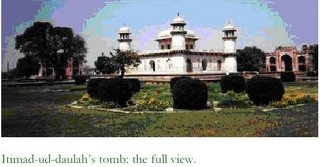
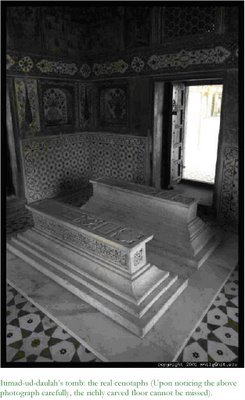 Itimad-ud-daulah’s tomb: The real cenotaphs (Upon noticing the above photograph carefully, the richly carved floor cannot be missed)
Itimad-ud-daulah’s tomb: The real cenotaphs (Upon noticing the above photograph carefully, the richly carved floor cannot be missed)Itimad-ud-daulah’s tomb at Agra, often dwarfed by the pristine glory of the Tajmahal was caused to be build by Noorjehan for her father. This highly ornate edifice is an ode to Noorjehan s creativity. I believe that people who visit Agra just to see the Tajmahal insult this wonderfully decorative and richly crafted monument that has so many firsts’ to its credit.
Historians maintain that it is the first structure in the architectural history of India wherein white marble supplants red sandstone for the floor. Almost every inch of the structure is ornately decorated with pietra dura, the Italian art of stone inlay (another first to the exceptional monument).
It would not be wrong to say that Noorjehan caused this lovely art to be imported from beyond the seas. It is an art that was perfected by Abdul Hamid Lahori, the chief architect of the Taj, while constructing the monument.
Coming back to Itimad-ud-daulah’s tomb, the walls of the tomb, floor, and ceiling are all covered in precious stones. My love for stones and the art of pietra dura in general compels me to explain a few things. Pietra Dura is an Italian art wherein cut-out pieces of colourful stones are embedded in marble.
The splendour and opulence of this art as displayed in the monument makes me pay 100 tributes the patron in Noor. History, I feel, has done injustice to the queen in forgetting her accomplishments just because she does not have a Taj to her credit.
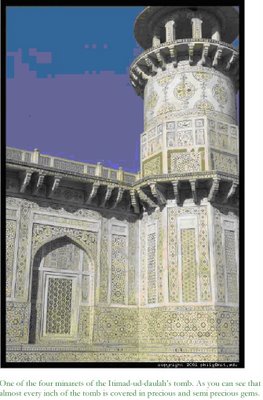
Close focus of one of the four minarets of the tomb. Notice that every inch of the structure is covered with precious and semi precious stones/gems

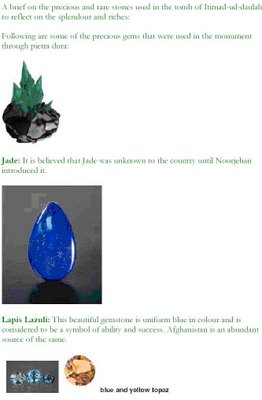

 Above is a brief about the kind and variety of gems that have been used in the Moghul structures. Apologies for the small print.
Above is a brief about the kind and variety of gems that have been used in the Moghul structures. Apologies for the small print.It seems that Noorjehan was particularly fond of jems and jewellery. Ardent collectors like the Salarjung family have preserved her daggers and other stone studded jewellery. Presently they are believed to be a popular display item at the Salarjung museum in Hyderabad.
Last Phase:
During the later years of Jehangir s life, Noorjehan strained her relationships with the members of her junta. Her own brother, Asaf Baig, colluded with prince Khurram and rebelled against the Emperor. Noorjehan desired a marriage alliance between Shahryar, Khurram s younger brother, and her daughter (Ladli Begum) from the first marriage. Her main motive was to support Shahryar s candidature to the throne despite prince Khurram’s obvious eligibility. History records that the rebels captured Jehangir and Khurram ascended to the throne as Emperor Shahjehan.
In 1607 Jehangir died and Noorjehan retired into solitude and later oblivion. Jehangir s tomb, another architectural marvel in red sandstone and marble was caused to be constructed by Noorjehan and Emperor Shahjehan in 1637 AD. It is in Lahore, in Pakistan. From the Mughal dynasty in India, Jehangir is the only emperor whose tomb is not in India.
Noorjehan, who was perhaps born to rule the world died like a prisoner (she was imprisoned by Shahjehan) in 1643 and is buried in Lahore. It is said that once her tomb had a marble cenotaph that she had built herself during her lifetime. However, history records that some Sikh marauders plundered the tomb and carted off the riches to decorate the Golden temple at Amritsar.
Thus, an eventful life, lived in splendour, extravagance and riches passed away in lonely quietude.
What makes Noorjehan take credence over other women of prominence is that she proved herself to be an astute administrator of an empire purely on the basis of her inherent capabilities and merit. Like Razia Sultan, Chand Bibi and Rani Laxmibai, she never wielded a sword to gain notice. Neither can she fall in the category of those bewitching beauties like the legendary Anarkali and Mumtazmahal whose only claim to fame is either a mismanaged, controversial and doubtful love affair or a mausoleum.
Interesting titbit: It has intrigued me beyond any measure to understand the habit of chewing paan amongst Muslim women in particular. My fidgeting curiosity was laid to rest when I came across the information that the habit of chewing paan was popularised by Noorjehan. She had discovered that by adding some ingredients to the leaf grants a natural red colour to the lips and used this knowledge as her very own cosmetic therapy!
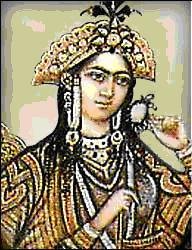
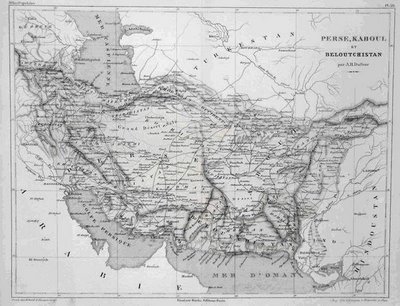
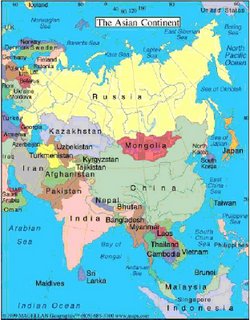
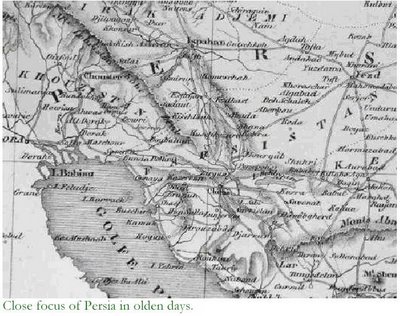
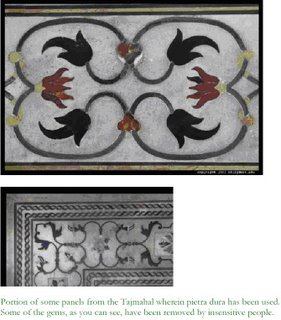
No comments:
Post a Comment